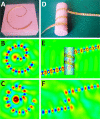Conformal surface plasmons propagating on ultrathin and flexible films
- PMID: 23248311
- PMCID: PMC3538259
- DOI: 10.1073/pnas.1210417110
Conformal surface plasmons propagating on ultrathin and flexible films
Abstract
Surface plasmon polaritons (SPPs) are localized surface electromagnetic waves that propagate along the interface between a metal and a dielectric. Owing to their inherent subwavelength confinement, SPPs have a strong potential to become building blocks of a type of photonic circuitry built up on 2D metal surfaces; however, SPPs are difficult to control on curved surfaces conformably and flexibly to produce advanced functional devices. Here we propose the concept of conformal surface plasmons (CSPs), surface plasmon waves that can propagate on ultrathin and flexible films to long distances in a wide broadband range from microwave to mid-infrared frequencies. We present the experimental realization of these CSPs in the microwave regime on paper-like dielectric films with a thickness 600-fold smaller than the operating wavelength. The flexible paper-like films can be bent, folded, and even twisted to mold the flow of CSPs.
Conflict of interest statement
The authors declare no conflict of interest.
Figures





Similar articles
-
Radiation-suppressed plasmonic open resonators designed by nonmagnetic transformation optics.Sci Rep. 2012;2:784. doi: 10.1038/srep00784. Epub 2012 Nov 7. Sci Rep. 2012. PMID: 23136641 Free PMC article.
-
Terahertz surface plasmon polaritons on periodically corrugated metal surfaces.Opt Express. 2008 Mar 3;16(5):3326-33. doi: 10.1364/oe.16.003326. Opt Express. 2008. PMID: 18542422
-
Optical properties of metal-dielectric-metal microcavities in the THz frequency range.Opt Express. 2010 Jun 21;18(13):13886-907. doi: 10.1364/OE.18.013886. Opt Express. 2010. PMID: 20588522
-
Spoof surface plasmonics: principle, design, and applications.J Phys Condens Matter. 2022 Apr 28;34(26). doi: 10.1088/1361-648X/ac6558. J Phys Condens Matter. 2022. PMID: 35390773 Review.
-
Radiation guiding with surface plasmon polaritons.Rep Prog Phys. 2013 Jan;76(1):016402. doi: 10.1088/0034-4885/76/1/016402. Epub 2012 Dec 19. Rep Prog Phys. 2013. PMID: 23249644 Review.
Cited by
-
High-order localized spoof surface plasmon resonances and experimental verifications.Sci Rep. 2015 Apr 15;5:9590. doi: 10.1038/srep09590. Sci Rep. 2015. PMID: 25873523 Free PMC article.
-
Spoof surface plasmon based planar antennas for the realization of Terahertz hotspots.Sci Rep. 2015 Dec 22;5:18606. doi: 10.1038/srep18606. Sci Rep. 2015. PMID: 26691003 Free PMC article.
-
Backward spoof surface wave in plasmonic metamaterial of ultrathin metallic structure.Sci Rep. 2016 Feb 4;6:20448. doi: 10.1038/srep20448. Sci Rep. 2016. PMID: 26842340 Free PMC article.
-
Strongly Confined Spoof Surface Plasmon Polaritons Waveguiding Enabled by Planar Staggered Plasmonic Waveguides.Sci Rep. 2016 Dec 5;6:38528. doi: 10.1038/srep38528. Sci Rep. 2016. PMID: 27917930 Free PMC article.
-
Plasmon-driven surface catalytic reaction of 4-ethynylaniline in a liquid environment.RSC Adv. 2018 Jun 5;8(37):20499-20504. doi: 10.1039/c8ra03326a. eCollection 2018 Jun 5. RSC Adv. 2018. PMID: 35542347 Free PMC article.
References
-
- Ritchie RH. Plasma losses by fast electrons in thin films. Phys Rev. 1957;106:874–881.
-
- Barnes WL, Dereux A, Ebbesen TW. Surface plasmon subwavelength optics. Nature. 2003;424(6950):824–830. - PubMed
-
- Maier SA. Plasmonics: Fundamentals and Applications. New York: Springer; 2007.
-
- Tsai W-H, Tsao Y-C, Lin H-Y, Sheu B-C. Cross-point analysis for a multimode fiber sensor based on surface plasmon resonance. Opt Lett. 2005;30(17):2209–2211. - PubMed
-
- Fang N, Lee H, Sun C, Zhang X. Sub-diffraction-limited optical imaging with a silver superlens. Science. 2005;308(5721):534–537. - PubMed
Publication types
MeSH terms
Substances
LinkOut - more resources
Full Text Sources

